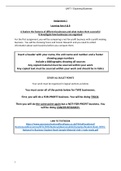UNIT 1 Exploring Business
Assignment 1
Learning Aim A & B
A Explore the features of different businesses and what makes them successful
B Investigate how businesses are organised
For the first assignment, you will be comparing a not-for-profit business with a profit-making
business. You will be choosing Tesco and Cancer Research and you need to collect
information about each business before you compare them.
Insert a header with your name, the unit name and number and a footer
showing page numbers
Include a bibliography showing all sources
Any copied material must be sourced within your work
Any copied text must be sourced within your work and should be in italics
COVER ALL BULLET POINTS
Your work must be organised in logical sections as below
You must cover all of the points below for TWO businesses.
First, you will do a FOR-PROFIT business. You will be doing TESCO.
Then you will do the same point again but a NOT-FOR-PROFIT business. You
will be doing CANCER RESEARCH.
LINK TO TEXTBOOK
https://www.pearsonschoolsandfecolleges.co.uk/FEAndVocational/
BusinessandEconomics/BTEC/BTECNationalsBusiness2016/Samples/Student-Book-/BTEC-
National-in-Business-Student-Book-Sample-Material-Unit-1-web-ready.pdf
1
, UNIT 1 Exploring Business
A.P1 Explain the features of two contrasting businesses.
A.P3 Explore the organisational structures, aims and objectives of two
contrasting businesses.
FEATURES OF THE BUSINESS (A.P1)
1) Ownership. How is the business owned? Include details about the history of the
business and any details of how it has grown over the years. Find any details of
share value, shareholders, profit from the last 2 years etc.
2) Explain the principle of limited liability and relate this to your business.
3) What is the purpose of the business? ie what products and/or services does it
supply? Explain in detail
4) What sector does the business operate in: primary, secondary, tertiary, quaternary?
5) Explain the scope of the business activities: is it local, national, international? Give
evidence for your choice
6) Explain the size of the business: small 10-49 staff, medium 50-249 staff, large 250+
staff. Find evidence of your choice
7) Can you find any other relevant information? E.g. Recent news stories
AIMS & OBJECTIVES (A.P3)
1) Explain the business Mission Statement, what is its vision and values?
2) Explain what SMART objectives are
3) Go on to explain the business aims and objectives which should be SMART. Find
details of the business aims & objectives eg private company is likely to be making
profits, profit maximisation, survival, growth, market leadership. Eg not for profit
may be education, housing, alleviating poverty, providing help/advice to certain
people, providing healthcare etc.
A.P2 Explain how two contrasting businesses are influenced by stakeholders.
A.M1 Assess the relationship and communication with stakeholders of two
contrasting businesses using independent research.
STAKEHOLDERS (A. P2)
1) What are stakeholders?
2) Who are the internal stakeholders? Eg managers, employees, owners
3) Who are the external stakeholders? Eg suppliers, lenders, competitors, debtors,
creditors, customers, government agencies/departments, communities (local,
national, international), pressure groups, interest groups.
4) Write about the relationship between the business and the internal and external
stakeholders. For this, you will need to research and find details about the interests
and influence of 5 external stakeholders and 2 internal stakeholders (their concerns,
what they want from the business, how much power they have over the business )
5) For each stakeholder write about the following: (A.M1)
2
, UNIT 1 Exploring Business
a. How does the business communicate with each stakeholder? (e.g. written,
oral, IT based, social media). Decide if they use the most effective and
suitable methods, giving reasons for your ideas (e.g. Tesco trying to
communicate with older customers via email is probably not a good idea)
b. Assess the relationship that the business has with each stakeholder. Make a
judgement on the relationship the business has with each stakeholder and
explain if you think it is a good or bad relationship and explain why
c. How does each type of stakeholder influence the business?
d. How does each type of stakeholder influence business success?
B.P3 Explore the organisational structures, aims and objectives of two
contrasting businesses.
B.M2 Analyse how the structures of two contrasting businesses allow each to
achieve its aims and objectives
ORGANISATIONAL STRUCTURE (B. P3) (B. M2)
1) Briefly explain the different types of organisational structure (hierarchical, flat,
matrix)
2) Find or create an organisational structure for the business. Is it hierarchical, flat,
matrix? Briefly explain the levels in the structure
3) Research and find details of at least 4 of the businesses functional
areas/departments eg human resources, research & development, sales, marketing,
purchasing, production & quality, customer service, IT, administration. Explain what
each function is responsible for and what their day to day tasks are.
Analyse how the structure of the business allows it to achieve its aim and objectives – You
must link to the objectives you discussed in the Aims & Objectives section. In order to do
this you should:
1) Identify the features of the business structure that allows the business to achieve its
aims and objectives. You need to focus on the advantages of the structure eg the
hierarchy structure helps the business achieve its aims and objectives because all
staff know who to report to and they know who to go to if they have a question. The
manager of each layer in the structure can communicate the aims and objectives of
the business to the staff in their departments.
2) Explain in detail how each functional area/department helps achieve its aims and
objectives. How do they work together to meet the objectives? Give at least 4
examples e.g. HR provides trained staff to offer customer service. You must link to
the objectives you discussed in the Aims & Objectives section (B.M2)
AB.D1 Evaluate the reasons for the success of two contrasting businesses,
reflecting on evidence gathered.
Possible reasons for success (AB.D1)
3




